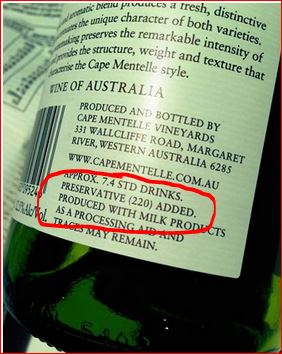Additives most likely to cause adverse reactions

The consumption of additives in food is a vexed issue. On the one hand, no-one plans to consume them in the first place and some – a limited number – have been linked to health problems ranging from asthma, wheezing, rashes, digestive upsets, behaviour problems in kids resulting in overactivity, lack of concentration and impulsiveness (hyperactivity).
On the other hand, additives help us live a fuller life if the products we buy can be stored without refrigeration, look attractive, keep for weeks without separating, drying out or crumbling, as well as allow us to eat out of season and minimise the need for salt or oil for preserving.
However, not all additives are harmful and I've already spelled out a short list of the ones that shouldn't worry us here. So what follows are my lists of the worst additives. For clarity, I've divided them down into Colours, Preservatives and Flavour Enhancers. I've listed all the possible additives from the food code but in practice only one or two from each group are commonly added to food. So you won't see ALL these additives when out shopping. I've highlighted in bold the commonly-used ones.
13 Colours
Many people blame sugar but it may be the colours that sugar keeps company with in items like lollies, chocolates, ice creams, soft drinks, cordials and snack foods that are the REAL cause of the problem.
Natural colours such as caramel (150a-d), beet red (162), chlorophyll (140, 141) and beta-carotene (160a) have a good safety record and pose no problem. No limit is put on their use in food and they can be added to all foods according to good manufacturing practice (called 'uncertified' by the US Food and Drug Administration).
However, artificial colours like tartrazine, Sunset Yellow FCF, erythrosine, amaranth and Brilliant Blue FCF have question marks hanging over them and have been linked to food sensitivity reactions. Tartrazine, once a common yellow colouring, has been extensively investigated for its ability to induce hives and asthma in aspirin-sensitive asthmatics. And they were used to test children's bad behaviour in the Southampton Study (more below). Because of these problems artificial colours cannot be added freely. Food regulations set limits on what type of foods they can be added to and at what levels. Here's my list of the 13 problem colours with their additive code number:
Colours - artificial
102 Tartrazine
110 Sunset yellow FCF
122 Azorubine
123 Amaranth
124 Ponceau 4R
127 Erythrosine
129 Allura red AC
132 Indigotine
133 Brilliant blue FCF
142 Food green S
151 Brilliant black BN
155 Brown HT
Colour - natural
160b Annatto extracts
May be added to:
Coloured foods like soft drinks, cordial, sweets, chocolate, packet desserts, cakes, biscuits, sauces, jelly crystals, toppings, snack foods, processed cheese, sauces, pickles, coloured medications and medication syrup for children.
Since 1997, Erythrosine use has been limited to maraschino cherries.
23 Preservatives
There are 5 groups of preservatives that are problematic:
1. Sorbates
Sorbates occur naturally in some fruits eg berries, but are synthesised and added to foods to inhibit the growth of moulds and yeasts that can cause foods to spoil (most commonly as potassium sorbate).
Potassium sorbate is a widely used preservative in food production as it's highly soluble, inexpensive and easily produced - this also makes it a popular choice for many industrial applications as well.
When added to water, potassium sorbate breaks down into sorbic acid and potassium. It is the sorbic acid that is active as an anti-microbial. It is more active at lower pH ie acidic mixes.
Potassium sorbate is widely regarded as safe and unlikely to be hazardous. A 2005 FSANZ study found even high consumers were unlikely to reach the ADI cut-off and overconsume it.
Both natural and added must be avoided on elimination diets to test for food sensitivities. Sorbic acid can cause contact dermatitis at concentrations above 0.5%. Studies show that if it is used at a concentration of not more than 0.2% it is unlikely to constitute a safety hazard.
200 Sorbic acid
201 Sodium sorbate
202 Potassium sorbate
203 Calcium sorbate
Commonly added to:
- Cottage cheese, yoghurt, dried meat, dried fruit, pickles, wine especially sweet and sparkling wine, apple cider, flavoured syrups and toppings.
- Also widely used in pharmaceuticals including syrups, eye, ear and nose drops, contact lens solution, and many herbal supplements.
- Many personal hygiene products use potassium sorbate e.g. cleansers, shampoos, moisturisers, anti-aging creams, hand creams, eye shadow, mascara, blush, hair colour, cream-based concealers and other liquid products. It prevents the products spoiling or breaking down as they sit on the shelf or in room temperature storage for long periods of time.
2. Benzoates
Benzoates occur naturally in cranberries, bilberries and other berries, vegetables, pepper, herbs, spices, peppermint and honey. Both natural and added must be avoided on elimination diets to test for food sensitivities.
210 Benzoic acid
211 Sodium benzoate
212 Potassium benzoate
313 Calcium benzoate
Commonly added to:
Non-cola soft drinks, cordials, orange juice and fruit drinks.
3. Sulphites or sulfites (sulphur-containing preservatives)

220 Sulphur dioxide
221 Sodium sulphite
222 Sodium bisulphite
223 Sodium metabisulphite
224 Potassium metabisulphite
225 Potassium sulphite
228 Potassium bisulphite
Commonly added to:
Dried apricots, dried apple, 'fresh' fruit salad, cordial, juice, fruit juice drinks, dried vegetables (like dried peas and instant mashed potato), pickled vegetables (like onions and gherkins), pickles, chutney, sausages, frankfurts, devon, vinegar, beer, wine, especially white wine in casks. They prevent the darkening of dried fruit and juices and are used to preserve soft drinks, pickled onions and sausages.
4. Propionates
All the propionates occur naturally in many foods and can be produced by bacteria as well eg in cheeses such as Swiss cheese.
280 Propionic acid
281 Sodium propionate
282 Calcium propionate
283 Potassium propionate
Commonly added to:
Breads, cakes, pastries as a mould inhibitor - calcium propionate 282 is the most common mould inhibitor and is used in humid weather where bread would otherwise go mouldy. Many bakeries now do not use it anymore so consume your bread within a couple of days or else freeze it for later eating.
5. Nitrites
Nitrites are on the watch list as they can be converted to nitrosamines in the body, which may cause cancer.
249 Potassium nitrite
250 Sodium nitrite
251 Sodium nitrate
252 Potassium nitrate
Commonly added to:
Ham, bacon, corned beef, salamis, hot dogs, frankfurters and cured and canned luncheon meats – think of all these as 'processed meats' and limit your intake.
9 Flavour enhancers
Generally flavour enhancers cause no harm at levels normally eaten. But high doses given under experimental conditions have been linked to food intolerance symptoms (almost always in combination with other chemicals like amines and salicylates).
Glutamates
621 Monosodium glutamate (MSG)
622 Monopotassium glutamate
623 Calcium glutamate
624 Monoammonium glutamate
625 Magnesium glutamate
Guanylates
627 Disodium guanylate
631 Disodium inosinate
635 Ribonucleotides
Hydrolysed Vegetable Protein (HVP) – no number
Commonly added to:
Soups, sauces, stock, gravies, seasonings, Asian and vegetarian dishes, flavoured crisps and snack foods, instant noodles. Asian cooks have used MSG extracted from seaweed for centuries as a way to flavour their dishes instead of salt.
The Worst Additives list in a handy formatAvoid these additives (with their additive code numbers) if you are worried about health problems: Artificial Colours Preservatives Flavour Enhancers
|
Natural alternatives
With shoppers ever wary of anything artificial and actively looking for clean-labels, natural colourings and natural preservatives look set to take over from synthetic alternatives in market value.
Even though natural colours have less consistency, less colour range and heat stability and are more expensive than their chemical alternatives, they've got the appeal. So our natural confectionery is now coloured with beet red or elderberry extract rather than red.
The Southampton Six
One of the most significant studies deterring consumers from artificial colourings was the Southampton Study published in 2007 in the Lancet.
It was a study of almost 300 children aged 3, 8 and 9 by the UK's University of Southampton. They tested reactions to a mixture of six colours and the preservative sodium benzoate (211), a preservative found in many lollies and soft drinks.
Results showed significant adverse affects on the children's behaviour with one mix but not another and in older children but less so in the 3 year olds.
It was not a completely compelling study but nonetheless most major companies, particularly those involved in producing products aimed at children, have been searching for natural alternatives to their synthetic colours since then.

The 6 food colours used in the study - which now have a voluntary ban in the UK - are:
- sunset yellow (E110)
- quinoline yellow (E104)
- carmoisine (E122)
- allura red (E129)
- tartrazine (E102)
- ponceau 4R (E 124)
These six controversial bright red or yellow colours are usually found in:
Lollies, chocolate, soft drink, cordial, sports drink, iced doughnuts, iced cupcakes, iced biscuits, cakes, muffins, flavoured milk, medicines, ice cream.
Reference: McCann D, Barrett A, Cooper A et al. Food additives and hyperactive behaviour in 3 year old and 8/9 yeal old children in the community: a randomised, double blinded, placebo controlled trial. Lancet 2007;370:1560-7







